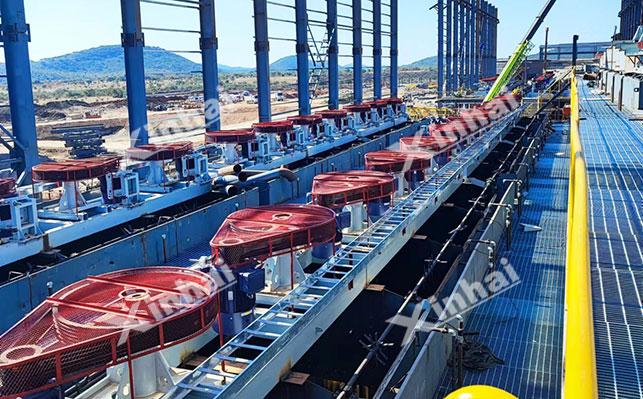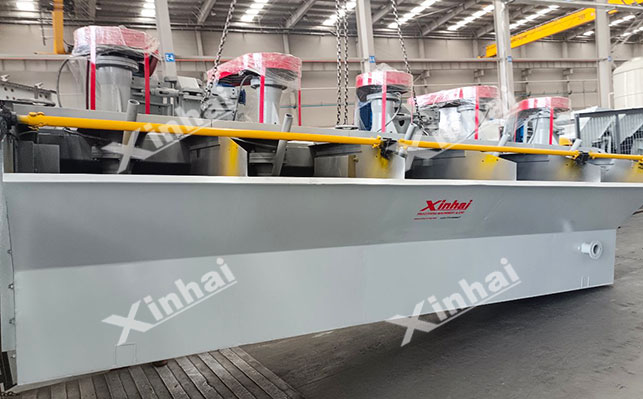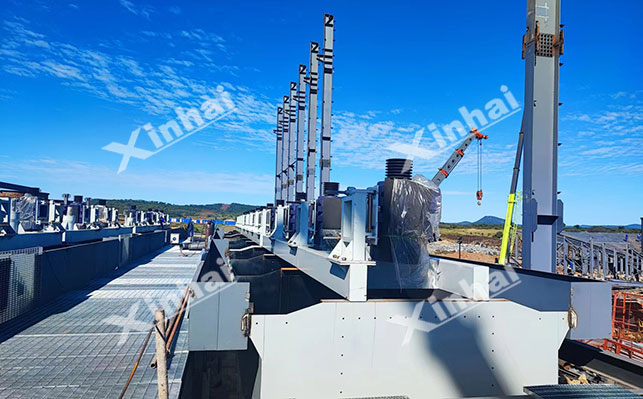
15311826613
Click to add WeChatLithium is an important resource that cannot be lacking in modern industry, and it is also the core material of lithium-ion batteries. With the booming electric vehicle industry and the rapid development of energy storage technology, the demand for lithium-ion batteries has exploded, which has greatly driven the demand for lithium. In addition, it is involved in the glass ceramic industry and the aerospace field. Flotation is one of the important methods for lithium extraction. We have introduced the flotation technology of lithium in the early stage. In this article, we will focus on the lithium flotation process.
The flotation process of lithium mainly includes ore preparation, flotation roughing, concentrating and scavenging.

Crushing: Lithium ore is usually in large blocks when mined and cannot be directly processed later. The purpose of crushing is to gradually crush these large pieces of lithium ore into smaller particles so that subsequent grinding and other operations can be carried out more efficiently. Jaw crushers and cone crushers are often used to complete the process. The former is used for preliminary crushing to reduce the ore particle size to 100-300 mm; the cone crusher performs medium and fine crushing operations to further reduce the ore particle size to less than 20 mm.
Grinding: Although the lithium ore particles have become smaller after crushing, they have not yet been fully dissociated from the gangue minerals. These ore particles need to be finely ground through grinding to achieve monomer dissociation of lithium minerals and gangue minerals as much as possible, creating good conditions for subsequent flotation operations. Because only when the lithium minerals are fully dissociated can the flotation agent better act on the surface of the lithium minerals to achieve effective separation of lithium minerals and gangue minerals. Generally, it is required that -200 mesh accounts for 60%-80%. The particle size of the grinding product can be accurately controlled by adjusting the cylinder speed of the ball mill or rod mill, the addition amount and ratio of steel balls or steel rods, the feeding speed, and the grinding time.
Slurry adjustment: The main purpose is to adjust the concentration, pH value and other properties of the slurry to create good conditions for subsequent flotation operations. Appropriate slurry concentration and pH value can make the flotation reagent play a better role and improve the flotation effect of lithium minerals. The process is that the slurry after grinding enters the stirring tank, adds an appropriate amount of water and adjusting agent, and uses sodium carbonate to adjust the pH value of the slurry to about 8-10. Through the rotation of the stirring device, the slurry and the added adjusting agent are fully mixed to ensure that the adjusting agent can be evenly dispersed in the slurry and fully react with the mineral particles in the slurry. When adjusting the slurry concentration, the properties of the ore, the performance of the flotation equipment and the requirements of the subsequent flotation process should be comprehensively considered. By controlling the water supply and slurry flow rate, the slurry concentration is adjusted to an appropriate range. In actual operation, it is necessary to regularly test the slurry concentration and adjust the water supply in time according to the test results.

Adding reagents: Adding collectors and frothers to the slurry after slurry adjustment is a key step in flotation roughing. The function of the collector is to adsorb on the surface of lithium minerals, changing its surface properties from hydrophilic to hydrophobic, so that it can attach to bubbles; the frother produces a large number of stable bubbles in the pulp, providing a carrier for the lithium mineral to attach, and realizing the initial separation of lithium minerals from gangue minerals. Common collectors include fatty acids (such as oleic acid, sodium oleate), phosphonates, etc., and frothers such as pine oil, octanol, etc. For different types of lithium ores, their surface properties and floatability are different, and it is necessary to select reagents in a targeted manner.
Roughing operation: After the pulp with the collector and frother enters the flotation machine, the flotation machine mixes the lithium mineral particles, reagents and bubbles in the pulp through stirring and aeration. Under the action of stirring force and bubble buoyancy, the hydrophobic lithium mineral particles quickly attach to the bubbles, and float to the surface of the pulp with the bubbles to form a foam layer. The foam layer is scraped out by the scraping device to obtain lithium rough concentrate, realizing the initial separation of lithium minerals and gangue minerals.

Multiple selection: The lithium rough concentrate obtained after rough selection still contains a certain amount of gangue minerals, which cannot meet the quality requirements of the final product. Therefore, multiple selections are required to further remove the gangue minerals mixed in the lithium concentrate and improve the grade of the lithium concentrate. Usually, an aerated flotation machine or a mechanical agitation flotation machine is used for selection operations. Through multiple selections, the grade of lithium concentrate is continuously improved and finally meets the product quality requirements.
Addition of flushing water: Adding flushing water is an important operation in the selection operation. Flushing water can clean the floating foam layer and further remove the gangue minerals mixed in the lithium concentrate. In actual operation, the amount and location of flushing water addition must be strictly controlled. Generally speaking, flushing water should be evenly sprayed on the surface of the foam layer, and the amount of addition should be determined according to the thickness and fluidity of the foam layer and the content of gangue minerals in the lithium concentrate.

Tailing treatment: There is still a small amount of lithium minerals in the tailings after roughing. In order to improve the recovery rate of lithium, the tailings are scavenged. During scavenging, the dosage of collector and frother is appropriately increased, and flotation is performed again. Compared with roughing, the dosage of collector and frother is appropriately increased during scavenging. In actual operation, the situation of the scavenging foam layer should be closely observed, and the amount of reagent added should be adjusted in time according to the recovery effect of lithium minerals and the quality of scavenging concentrate.
Scavenging product: The foam product obtained by scavenging is scavenging concentrate. Returning it to roughing or concentrating operations can further recover the lithium minerals therein and improve the overall recovery rate of lithium, while the tailings after scavenging are discharged as the final tailings. The scavenging concentrate has a high content of lithium minerals but also more impurities. It is usually returned to the roughing operation and floated again with the original ore pulp. The strong stirring and large dosage of reagents in the roughing are used to separate the lithium minerals and impurities again.
The above is an introduction to the flotation process of lithium ore. In actual mineral processing plants, due to the different properties of lithium ores, although the flotation process basically follows this process, the number of processes required for each link is different, and a lithium flotation process suitable for the ore itself needs to be designed according to the properties of the ore. In addition, for ores containing multiple lithium minerals or associated with other valuable minerals, a more complex combined mineral processing process may be required, including gravity separation, magnetic separation, electrostatic separation and other methods combined with flotation to achieve effective separation and comprehensive recovery of various minerals.